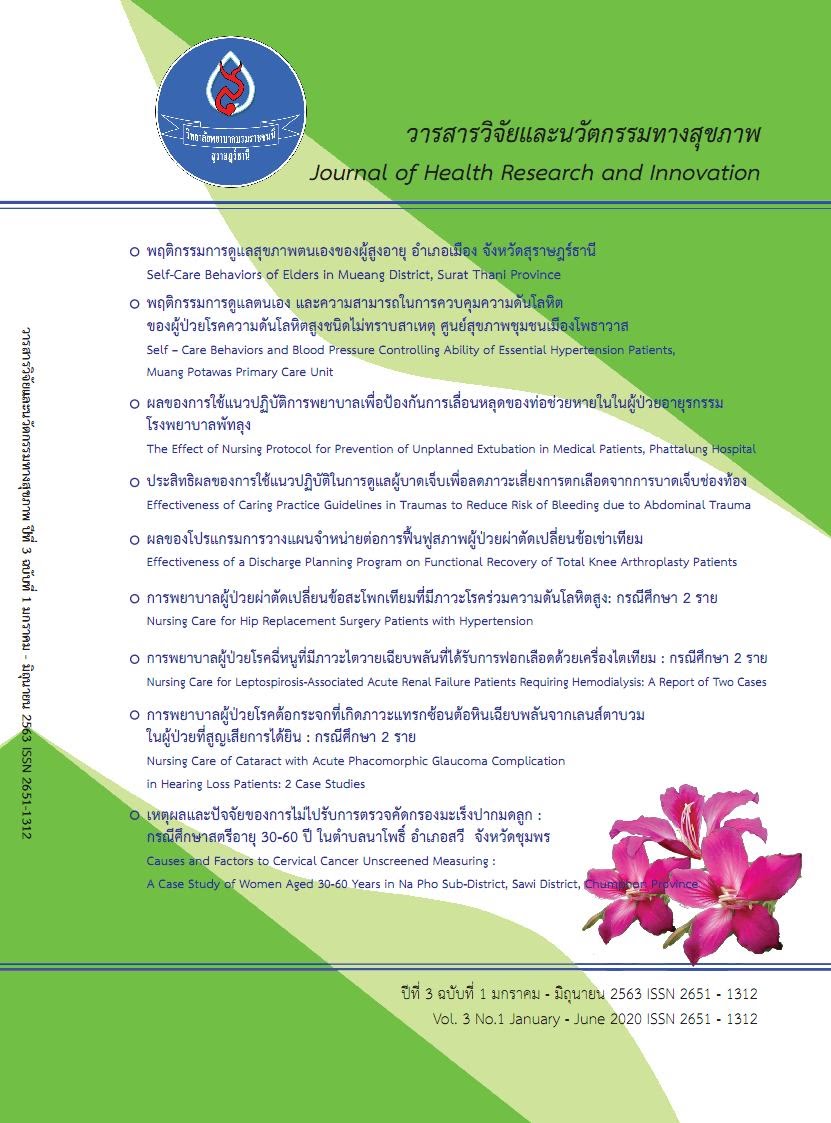ผลของการใช้แนวปฏิบัติการพยาบาลเพื่อป้องกันการเลื่อนหลุดของท่อช่วยหายใจในผู้ป่วยอายุรกรรม โรงพยาบาลพัทลุง
คำสำคัญ:
แนวปฏิบัติการพยาบาล, การเลื่อนหลุดของท่อช่วยหายใจบทคัดย่อ
การวิจัยนี้เป็นการศึกษาแบบกึ่งทดลอง มีวัตถุประสงค์เพื่อเปรียบเทียบผลของการใช้แนวปฏิบัติการพยาบาลเพื่อป้องกันการเลื่อนหลุดของท่อช่วยหายใจ ในผู้ป่วยอายุรกรรม กลุ่มตัวอย่างเลือกแบบเฉพาะเจาะจง จากผู้ป่วยที่ได้รับการใส่ท่อช่วยหายใจและเข้ารับการรักษาในหอผู้ป่วย อายุรกรรมทั่วไปและหอผู้ป่วยหนักอายุรกรรมแบ่งเป็น 2 กลุ่มกลุ่มละ 51 คน กลุ่มควบคุมคือกลุ่มที่ได้รับการดูแลตามปกติ เลือกกลุ่มตัวอย่างจากเวชระเบียนผู้ป่วยที่เข้ารับการรักษา ระหว่างเดือนตุลาคมถึงเดือนธันวาคม พ.ศ. 2562 และกลุ่มทดลองคือกลุ่มที่ใช้แนวปฏิบัติการพยาบาลที่พัฒนาขึ้นจากหลักฐาน เชิงประจักษ์ที่เข้ารับการรักษา ระหว่างเดือนกุมภาพันธ์ถึงเดือนเมษายน พ.ศ.2563 แนวปฏิบัติการพยาบาลประกอบด้วย 1) การให้ข้อมูลแก่ผู้ป่วย/ครอบครัวและส่งเสริมการมีส่วนร่วม ในการดูแล 2) การประเมินภาวะกระสับกระส่าย/กระวนกระวายการให้ยาระงับประสาท/ยาคลายกล้ามเนื้อและการผูกยึดผู้ป่วย 3) การผูกยึดท่อช่วยหายใจ 4) การประเมินความปวดและการจัดการความปวดอย่างเหมาะสม 5) แนวปฏิบัติการพยาบาลผู้ป่วยที่ใส่ท่อช่วยหายใจและเครื่องช่วยหายใจ และ 6) การหย่าเครื่องช่วยหายใจ เก็บข้อมูลโดยใช้แบบบันทึกข้อมูลพื้นฐานและข้อมูลด้านความเจ็บป่วยและแบบบันทึกข้อมูลการเกิดอุบัติการณ์ท่อช่วยหายใจเลื่อนหลุด วิเคราะห์ข้อมูลโดยใช้สถิติเชิงบรรยาย Fisher’s Exact test, Chi-Square และ Mann-Whitney U test พบว่าอัตราการเกิดอุบัติการณ์ท่อช่วยหายใจเลื่อนหลุดของผู้ป่วยที่ได้รับการดูแลตามปกติ เท่ากับ 0.196 (ร้อยละ 19.60) และอัตราการเกิดอุบัติการณ์ท่อช่วยหายใจเลื่อนหลุดของผู้ป่วยที่ได้รับการดูแลตามแนวปฏิบัติการพยาบาล เท่ากับ 0.039 (ร้อยละ 3.90) อุบัติการณ์ท่อช่วยหายใจเลื่อนในกลุ่มทดลองต่ากว่ากลุ่มควบคุมอย่างมีนัยสำคัญทางสถิติที่ระดับ .05 ดังนั้นจึงควรนาแนวปฏิบัติการพยาบาลไปประยุกต์ใช้ ในการดูแลผู้ป่วยที่ใส่ท่อช่วยหายใจให้ครอบคลุมทุกแผนกของโรงพยาบาล
เอกสารอ้างอิง
Bangaorn, N., Ampaporn, N., & Nam-oy, P. (2015). Unplanned extubation and duration of mechanical ventilation in critically ill patients on evidenced based nursing practice. Kuakarun Journal of Nursimg, 22(1), 129-143. (in Thai)
Chen, C. M., Chan, K. S., Fong, Y., Hsing, S. C., Cheng, A. C., Sung, M. Y., et al. (2010).Age is an important predictor of failed unplanned extubation. Int J
Gerontol, 4(3), 120-9. Faul, F., Erdfelder, E., Buchner, A., & Lang, A.-G. (2009). Statistical power analyses using G*Power 3.1: Tests for correlation and regression analyses. Behavior Research Methods, 41, 1149-1160.
Gustad, T. L., Chaboyer, W., & Wallia, M. (2008).”ICU patient’s transfer anxiety: A prospective cohot study”. Australian Critical Care, 21,181-189.
Jarachovic. M., Mason, M. M., Kerber, K., & Mcnett, M. (2011) The role of standardized protocols in Unplanned Extubations in a medical intensive care unit. American Journal of Critical Care, 20(4), 304-11.
Kiekkas, P., Aretha, D., Panteli, E., Baltopoulos, G., Filos, S. (2012).Unplanned extubation in critically ill adults: clinical review. Nursing of Critical Care, 18(3), 123-34.
Maneenuch, S., Kanittha, K., & Wassana, N. (2017). Effects of Utilizing clinical nursing practice guideline on the incidence of unplanned extubation in crittcally ill patients. Journal of Nursing and Education, 10(2), 58-70. (in Thai)
Pramote, W. (2019). Experimental Research Design: Application for Research to Improve Health Behaviors Bangkok: Jariondeemonkongkanpim.
Samlee, K., Ratree, S., Yupa, P., & Sompong, J. (2019). Effectiveness of Implementing Clinical Nursing Practice Guideline for Preventing Unplanned
Extubation in Intensive Care Unit at Nakhonathom Hospital. Region 4-5 Medical Journal, 38(3), 210-225. (in Thai)
Silva, P. S., & Fonseca, M. C. (2012). Unplanned endotracheal extubations in the intensive care unit: systematic review, critical appraisal and evidence-based recommendations. Anesth Analg, 114, 1003-14.
Somporn, N., Rachanee, N., & Varin, B. (2016). The effect of nursing care protocol on the incidence rates of unplanned extubation in patients with endotracheal intubation. The Journal of Cardio-Thoracic Nursing, 27(1), 72-84. (in Thai)
Stites, M. (2013).Observational Pain Scales in Critically Ill Adults. Critical Care Nurse, 33(3), 68-78
Supian, P., Patcharawan, S., Tisakorn, S., Phitchayada, D., Prapassom, K., & Nadanong, S. (2019). Prevalence risk factor and nursing care of unplanned extubation: An integrative review. Journal of Health Science, 3(3), 53-67. (in Thai)
Thongplaill, K. (2008). Effect of nursing care protocol on incidence of unplanned extubation in patients with endotracheal tube. (Master Thesis of Nursing Science). Pathum Thani: Rangsit University. (in Thai)
Tominaga, G. T., Rudzwick, H., Scannell, G., & Waxman, K. (1995). Decreasing unplanned extubations in the surgical intensive care unit. The American Journal of Surgery, 170(9), 586-590.
Wiparat, N., Panomporn, P., Parichat, S., Pathumporn, K., & Suweena, B. (2017). Effect of PMK unplanned extubation prevention program on extubation rate in Medical wards, Pramongkutklao Hospital.Journal of the Royal Thai Army Nurse, 18(1), 167-175. (in Thai)
ดาวน์โหลด
เผยแพร่แล้ว
รูปแบบการอ้างอิง
ฉบับ
ประเภทบทความ
สัญญาอนุญาต
บทความที่ได้รับการตีพิมพ์เป็นลิขสิทธิ์ของวารสารวิทยาลัยพยาบาลบรมราชชนนี สุราษฎร์ธานี
ข้อความที่ปรากฏในบทความแต่ละเรื่องในวารสารวิชาการนี้เป็นความคิดเห็นส่วนตัวของผู้เขียนแต่ละท่านไม่เกี่ยวข้องกับวิทยาลัยพยาบาลบรมราชชนนี สุราษฎร์ธานี และคณาจารย์ท่านอื่นๆในวิทยาลัยฯ แต่อย่างใด ความรับผิดชอบองค์ประกอบทั้งหมดของบทความแต่ละเรื่องเป็นของผู้เขียนแต่ละท่าน หากมีความผิดพลาดใดๆ ผู้เขียนแต่ละท่านจะรับผิดชอบบทความของตนเองแต่ผู้เดียว



